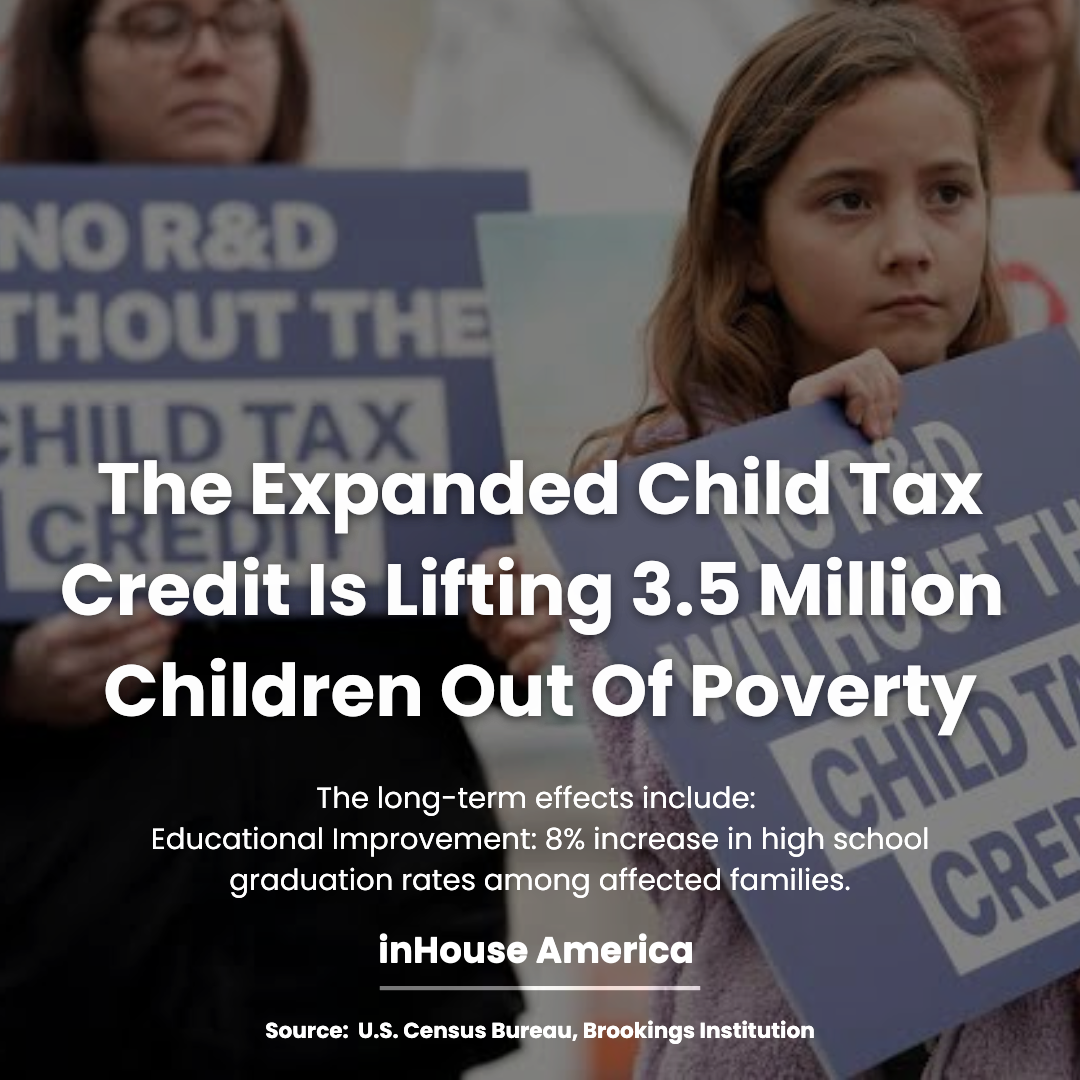InHouse America
In-Depth Data Analysis: Kamala Harris' Tax Plans
Published: 18:00 pm (GMT-5), Fri September 6, 2024
5 Minute Read

Source: (U.S. Census Bureau, Brookings Institution)
Corporate Tax Increase from 21% to 28%
(Policy Positive Impact Potential)
This increase could result in a 5% decrease in profit margins for multinational corporations, potentially redirecting $300 billion annually back into the U.S. economy.
Source: (Congressional Budget Office (CBO), U.S. Treasury)
Insights: Up to 2 million new jobs over the next decade, particularly in tech and manufacturing. 4% more capital investment in domestic sectors like renewable energy and infrastructure.
Increased Child Tax Credit (from $2,000 to $3,600)
(Policy Positive Impact Potential)
Educational Improvement: 8% increase in high school graduation rates among affected families. Wealth Growth: Future earnings of these children could increase by $40 billion.
Source: (U.S. Census Bureau, Brookings Institution)
Insights: Reduced Welfare Dependency: A 20% decrease in reliance on social welfare programs over time.
Earned Income Tax Credit (EITC) Expansion
(Policy Positive Impact Potential)
Consumer Spending Boost: $20 billion increase in annual consumer spending. Small Business Revenue: 5% increase in revenue for small businesses in low-income areas.
Source: (U.S. Department of Treasury, U.S. Small Business Administration (SBA))
Insights: Job Creation: 300,000 new jobs in local economies.
Top Marginal Tax Rate Increase (from 37% to 39.6%)
(Policy Positive Impact Potential)
Investment Shift: 3% increase in long-term investments in sectors such as clean energy. Job Growth: Potential creation of 500,000 new jobs in growth sectors.
Source: (Congressional Budget Office (CBO), Tax Policy Center)
Insights: Economic Impact: 0.5% increase in overall GDP growth due to more stable investments.
Green Energy Tax Credits
(Policy Positive Impact Potential)
Investment Surge: 25% increase in renewable energy investments. Job Creation: Up to 1.2 million new jobs in clean energy sectors.
Source: (U.S. Department of Energy, National Bureau of Economic Research (NBER))
Insights: Emission Reduction: 15% decrease in U.S. carbon emissions.
Impact on Small Businesses
(Policy Negative Impact Potential)
Job Loss: Potential reduction of 250,000 jobs among small businesses. Growth Slowdown: 2% decrease in job growth and expansion efforts, particularly among businesses earning over $400,000 annually.
Source: (U.S. Small Business Administration (SBA))
Insights: Direct impact on 30 million small business owners and their employees.
Reduced Incentive for Capital Investment
(Policy Negative Impact Potential)
Economic Output: $30 billion annual loss in capital investment. GDP Growth: 0.3% decrease in annual GDP growth. Job Impact: Potential loss of 2 million jobs in investment-driven sectors.
Source: (Tax Policy Center, National Bureau of Economic Research (NBER))
Insights: Indirect impact on 1.4 million high-net-worth individuals and broader economic sectors.
Top Marginal Tax Rate Effects on Small Businesses
(Policy Negative Impact Potential)
Job Reduction: 50,000 jobs lost annually due to slower business expansion. Entrepreneurial Stagnation: 5% decrease in new business startups.
Source: (Congressional Budget Office (CBO))
Insights: Impact on 5% of small business owners earning over $400,000 annually.
Wealth Tax Enforcement Costs
(Policy Negative Impact Potential)
Compliance Costs: Reduce the effectiveness of the wealth tax, consuming 40% of the revenue. Tax Processing Delays: Increase tax processing times by 15%, affecting 20 million middle-income taxpayers.
Source: (Tax Foundation, U.S. Treasury)
Insights: Directly affects the top 0.1% of households; indirect impact on broader taxpayer processing.
Potential Slower Wage Growth
(Policy Negative Impact Potential)
Wage Loss: $500 billion total loss in wages over a decade. Consumer Spending: $100 billion decrease in annual consumer spending. Retail Impact: 1.5% drop in retail sales affecting low-income workers.
Source: (National Bureau of Economic Research (NBER), Bureau of Labor Statistics (BLS))
Insights: Affected Population: Direct impact on 160 million workers employed by U.S. corporations.
InHouse America Opinion
Kamala Harris' tax proposals present well-known benefits such as increased revenue and poverty reduction, but their deeper impacts include significant shifts in investment patterns, wealth distribution, and economic growth.
Insights: Understanding these detailed data points provides a clearer picture of how these policies could influence the U.S. economy in both the short and long term, affecting millions of individuals and various sectors across the nation.
InHouse America doesn't endorse anyone but focuses on creating awareness of the importance of supporting small businesses and which administration is best for doing so!